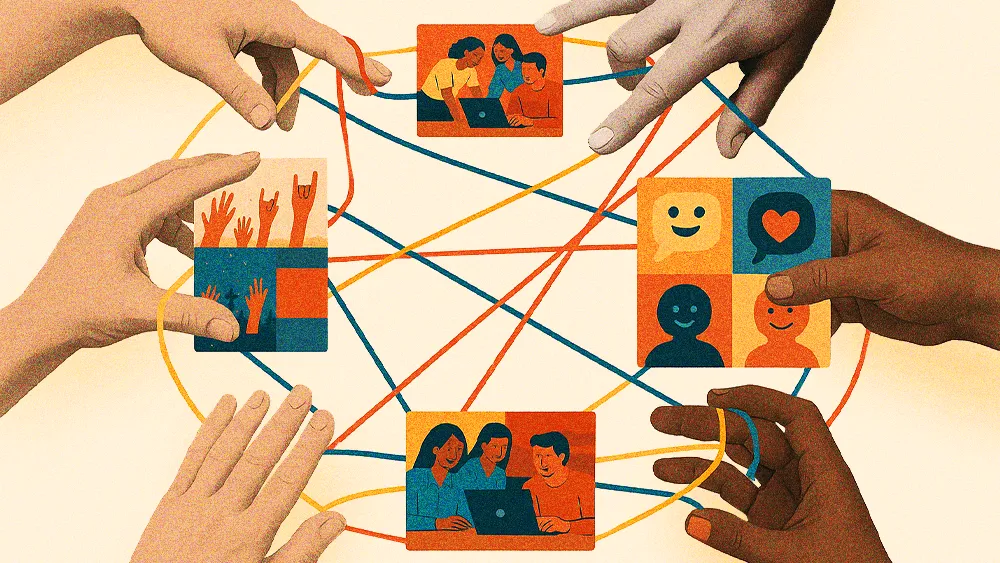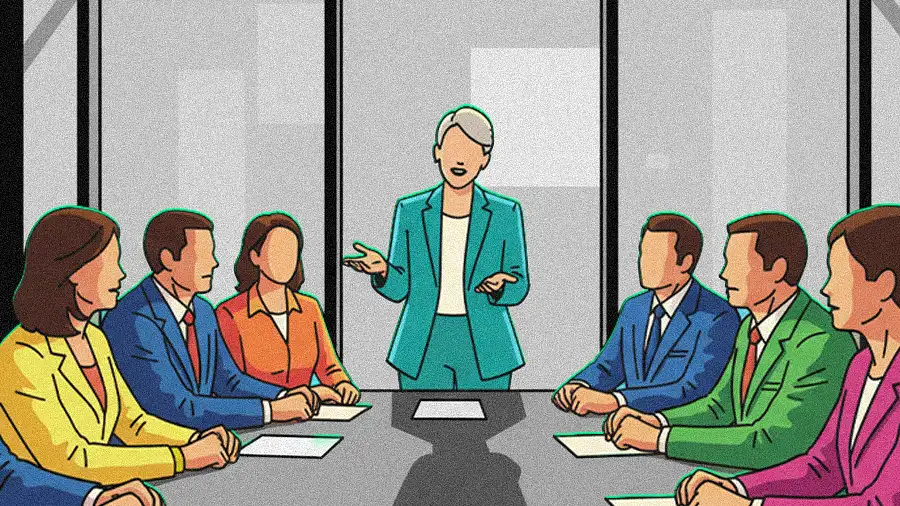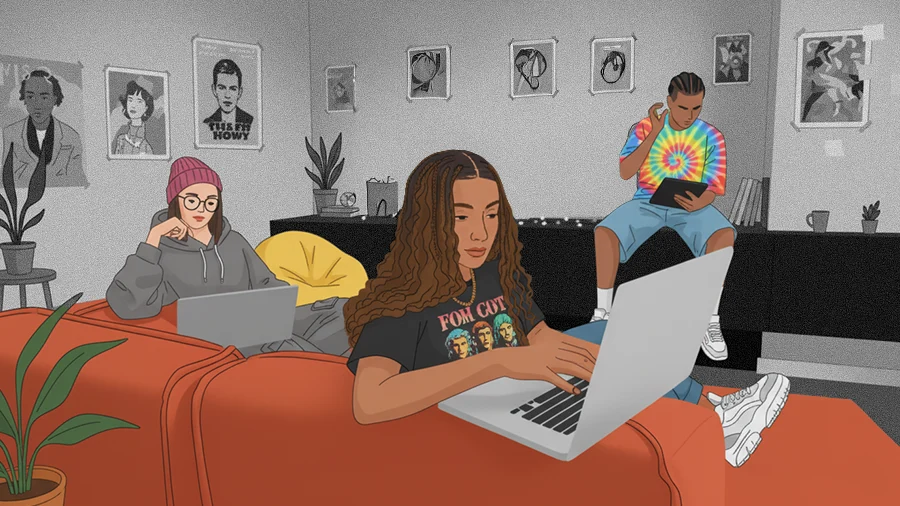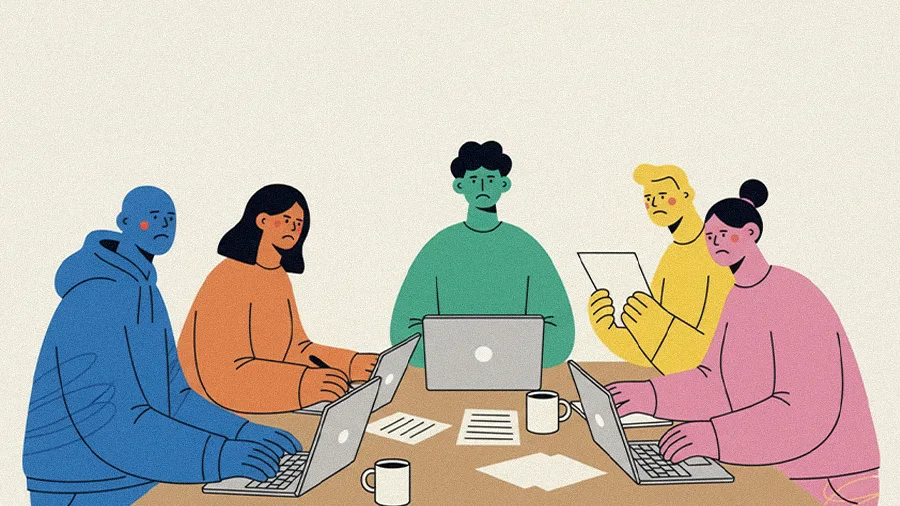What a pop culture phenomenon teaches leaders about connection

Key Points
The strategy behind Taylor Swift’s powerful brand loyalty offers lessons for both external marketing and internal team-building.
Amy Burrows, Vice President of Digital at Venus Media, explains how leaders can build deep brand equity by showing up where their community already is.
Burrows also highlights how pop culture moments can serve as a “digital water cooler,” fostering connection and social capital within remote teams.
However, she cautions leaders to remain aware of potential exclusion and ensure these bonding moments remain open to everyone.
In marketing and advertising, you show up where people are, not where you want them to be. For her engagement announcement, Taylor didn't do an exclusive with People magazine. She went right to the people who follow her and are cheering for her. Her fans felt like 'Taylor posted that for me.'

Amy Burrows
Vice President of Digital
Venus Media
The biggest lesson in branding right now isn’t happening in a boardroom. It’s unfolding across social media feeds and on the world’s largest stages. A pop culture moment has become a masterclass in crafting a deeply loyal community, built on a deep sense of investment, leaving millions perpetually asking, “What’s next?” A new report on the Swift Shift found that Taylor Swift’s brand is so powerful, 6% of salaried workers are taking off October 3 for the release of her next album, The Life of a Showgirl.
This strategy of intentional, long-term engagement creates an “invisible string” of connection between a brand and its audience. But the same principle applies within an organization. For leaders, these cultural moments offer a powerful tool to build the same kind of connection within their teams, strengthening the trust that enables collaboration.
We spoke with Amy Burrows, Vice President of Digital at Venus Media, to deconstruct this phenomenon. She argues that the principles behind this level of fandom are not celebrity magic, but scalable business strategies that any company can learn from. The core of Taylor Swift’s strategy, for example, is a disciplined commitment to showing up where her community already is.
Go where your people are: This builds a direct, personal-feeling relationship that traditional media gatekeepers can’t replicate. “In marketing and advertising, you show up where people are, not where you want them to be,” Burrows said. “For her engagement announcement, Taylor didn’t do an exclusive with People magazine. She went right to the people who follow her and are cheering for her. Her fans felt like ‘Taylor posted that for me.'”
Breadcrumb for the future: This deep engagement is the result of meticulous, long-term planning. By embedding clues and narratives over time in an “Easter egg strategy,” a brand can create a sense of shared discovery and investment. “Taylor’s so strategically driven,” she said. “Years out, she’ll be planting a breadcrumb moment for you. It creates brand loyalty and a sense of equity or investment in ‘What’s she gonna do next?'”
While replicating a global phenomenon seems impossible, Burrows insists the methodology is scalable. It’s about adopting the same intentionality, whether you’re a tech giant or a local business. “We can take those lessons of being super intentional and apply it to any industry,” she said. “As an example: If we’re recruiting teachers, we can say, ‘Let’s go to channels where we know future teachers are studying and learning and turn over all those rocks to find them.’ It’s also knowing that you can’t be that big overnight either.”
Brands as emotional connectors: This consistency builds an emotional connection that becomes part of a brand’s identity. When that identity is violated, the audience feels it personally. “Brands are an emotional connection,” Burrows said. “If you go off-brand or off-script, people know. It’s like when you’re having a bad day and someone asks, ‘Are you alright? You’re not yourself.’ Your brand can have that same experience.”
Beyond external marketing, these cultural touchstones serve a powerful internal purpose. They become the new digital water cooler, allowing teams in a remote or hybrid environment to connect on a human level. “We recently had a debate on our team about The Summer I Turned Pretty,” she said. “One of our coworkers is convinced that Taylor and Travis are a PR stunt, while the other half believes it’s true love. You use those pop culture moments for that bigger invisible string where everyone can relate, without having to unveil personal details about yourself.”
But does this “chitchat” produce tangible business results? Burrows argues it does, by building the trust that is foundational to collaboration. She shared a story that proves the benefit isn’t just immediate morale, but durable, long-term social capital.
Social capital: “Years ago, during COVID, I was constantly looking for virtual ways to connect with the team,” she said. “We did a murder mystery team builder. About six months ago, two of my former coworkers texted me, ‘Amy, do you remember this?'” This story shows that it’s the quiet connections that create long-lasting trust within a team, making it easier to work together and have fun at the same time.
While pop culture can be a tool for inclusion, it can just as easily become a source of exclusion if not managed with awareness. Leaders have a responsibility to ensure these conversations unite, rather than divide. “As a leader, you have to ensure there isn’t some secret chat that the whole team is in on except for three people,” Burrows said. “It’s about making sure that everyone feels included. You want them to feel good about coming to work and not feel like their beliefs are being attacked.”
As a leader, you have to ensure there isn't some secret chat that the whole team is in on except for three people. It's about making sure that everyone feels included. You want them to feel good about coming to work and not feel like their beliefs are being attacked.

Amy Burrows
Vice President of Digital
Venus Media
As a leader, you have to ensure there isn't some secret chat that the whole team is in on except for three people. It's about making sure that everyone feels included. You want them to feel good about coming to work and not feel like their beliefs are being attacked.

Amy Burrows
Vice President of Digital
Venus Media
Related articles
TL;DR
The strategy behind Taylor Swift’s powerful brand loyalty offers lessons for both external marketing and internal team-building.
Amy Burrows, Vice President of Digital at Venus Media, explains how leaders can build deep brand equity by showing up where their community already is.
Burrows also highlights how pop culture moments can serve as a “digital water cooler,” fostering connection and social capital within remote teams.
However, she cautions leaders to remain aware of potential exclusion and ensure these bonding moments remain open to everyone.

Amy Burrows
Venus Media
Vice President of Digital

Vice President of Digital
The biggest lesson in branding right now isn’t happening in a boardroom. It’s unfolding across social media feeds and on the world’s largest stages. A pop culture moment has become a masterclass in crafting a deeply loyal community, built on a deep sense of investment, leaving millions perpetually asking, “What’s next?” A new report on the Swift Shift found that Taylor Swift’s brand is so powerful, 6% of salaried workers are taking off October 3 for the release of her next album, The Life of a Showgirl.
This strategy of intentional, long-term engagement creates an “invisible string” of connection between a brand and its audience. But the same principle applies within an organization. For leaders, these cultural moments offer a powerful tool to build the same kind of connection within their teams, strengthening the trust that enables collaboration.
We spoke with Amy Burrows, Vice President of Digital at Venus Media, to deconstruct this phenomenon. She argues that the principles behind this level of fandom are not celebrity magic, but scalable business strategies that any company can learn from. The core of Taylor Swift’s strategy, for example, is a disciplined commitment to showing up where her community already is.
Go where your people are: This builds a direct, personal-feeling relationship that traditional media gatekeepers can’t replicate. “In marketing and advertising, you show up where people are, not where you want them to be,” Burrows said. “For her engagement announcement, Taylor didn’t do an exclusive with People magazine. She went right to the people who follow her and are cheering for her. Her fans felt like ‘Taylor posted that for me.'”
Breadcrumb for the future: This deep engagement is the result of meticulous, long-term planning. By embedding clues and narratives over time in an “Easter egg strategy,” a brand can create a sense of shared discovery and investment. “Taylor’s so strategically driven,” she said. “Years out, she’ll be planting a breadcrumb moment for you. It creates brand loyalty and a sense of equity or investment in ‘What’s she gonna do next?'”
While replicating a global phenomenon seems impossible, Burrows insists the methodology is scalable. It’s about adopting the same intentionality, whether you’re a tech giant or a local business. “We can take those lessons of being super intentional and apply it to any industry,” she said. “As an example: If we’re recruiting teachers, we can say, ‘Let’s go to channels where we know future teachers are studying and learning and turn over all those rocks to find them.’ It’s also knowing that you can’t be that big overnight either.”
Brands as emotional connectors: This consistency builds an emotional connection that becomes part of a brand’s identity. When that identity is violated, the audience feels it personally. “Brands are an emotional connection,” Burrows said. “If you go off-brand or off-script, people know. It’s like when you’re having a bad day and someone asks, ‘Are you alright? You’re not yourself.’ Your brand can have that same experience.”

Amy Burrows
Venus Media
Vice President of Digital

Vice President of Digital
Beyond external marketing, these cultural touchstones serve a powerful internal purpose. They become the new digital water cooler, allowing teams in a remote or hybrid environment to connect on a human level. “We recently had a debate on our team about The Summer I Turned Pretty,” she said. “One of our coworkers is convinced that Taylor and Travis are a PR stunt, while the other half believes it’s true love. You use those pop culture moments for that bigger invisible string where everyone can relate, without having to unveil personal details about yourself.”
But does this “chitchat” produce tangible business results? Burrows argues it does, by building the trust that is foundational to collaboration. She shared a story that proves the benefit isn’t just immediate morale, but durable, long-term social capital.
Social capital: “Years ago, during COVID, I was constantly looking for virtual ways to connect with the team,” she said. “We did a murder mystery team builder. About six months ago, two of my former coworkers texted me, ‘Amy, do you remember this?'” This story shows that it’s the quiet connections that create long-lasting trust within a team, making it easier to work together and have fun at the same time.
While pop culture can be a tool for inclusion, it can just as easily become a source of exclusion if not managed with awareness. Leaders have a responsibility to ensure these conversations unite, rather than divide. “As a leader, you have to ensure there isn’t some secret chat that the whole team is in on except for three people,” Burrows said. “It’s about making sure that everyone feels included. You want them to feel good about coming to work and not feel like their beliefs are being attacked.”




